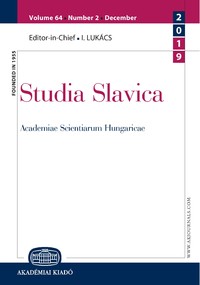Архетипний образ вогню в лінгвопросторі українських паремій і замовлянь
The Archetypal Image of Fire in Language Space of Ukrainian Paroemias and Verbal Folk Magic
Author(s): Anatolii Vasylovych Vysotskyi, Yulia Sergiyivna MakaretsSubject(s): Eastern Slavic Languages
Published by: Akadémiai Kiadó
Keywords: ethnolinguistics; archetypal image; lingualization; verbalizer; archetype; fire; verbal folk magic; paroemia; proverb
Summary/Abstract: This paper deals with the linguocultural analysis of the semantic content of the archetypal symbol of fire. It is one of the deep mental formations, a manifestation of the collective subconscious, the generic memory, so its shades of meaning are best expressed in micro- contexts that retain stereotypical associations and evaluations for a certain ethnos as well as in the linguistic formulas of word magic, which is inherent in primitive consciousness. Such are the texts of paroemias and verbal folk magic, on the basis of which the research is conducted. Although ancient Ukrainians knew the cult of fire and thought that it had a divine power, the analyzed linguistic microcontexts did not show the lingualization of deification of fire. Fire appears as an ambivalent element, destructive but simultaneously life-giving, with the predominance of negative marking. Fire mostly is opposed to water, which is also an ambivalent element but with a positive beginning. Ukrainian paroemiology predominantly testifies stereotypical associative similarity of fire and misfortune or trial, more rarely – of fire and strong destructive feelings or restless nature. Analyzed Ukrainian proverbs do not contain Christian understanding of fire, only ancient, pagan ideas about it. In verbal magic, fire is a part of homeopathic magic, an element that can scare off a dis- ease or burn it, that is, cure the like with the like. More rarely, fire is a part of love magic based on similarity of natural fire and the fire of feelings. Of particular interest in this con- text is the image of ‘fiery bugalo’ that burns, causing a love fever. This image is connected with the cult of the seductive serpent, a mythical creature that can install a ‘fire of love’ in the heart of a man, and appears to women as tempting young man. The mediator of the idea of fire is also the word-concept ‘candle’. This symbol im- plements the semantics of faith and mind. In religious tradition, it becomes the emblem of the church and the spiritual light. Paroemiological units mostly attest to its use in combi- nation with the word-concept ‘devil’. Such microcontexts can be explained by the ability of people to pick up and summarize the paradoxical manifestations of everyday life. Ethno- graphic studies suggest that the semantics of sun and lightning also intersect with the sym- bolic meaning of fire, although this is not confirmed by the analyzed paroemological micro- contexts. The cognitive basis of such symbolization are the mechanisms of associative assimila- tion and comparison through which the primeval people cognized and structured the world. The symbol of fire becoming the basis of paroemological and magical microcontexts is sometimes not lingualized directly and manifests itself through typical scenarios with pred- icates to smoke, to burn, to scorch, etc.
Journal: Studia Slavica Academiae Scientiarum Hungaricae
- Issue Year: 64/2019
- Issue No: 2
- Page Range: 441-451
- Page Count: 11
- Language: Ukrainian
- Content File-PDF

